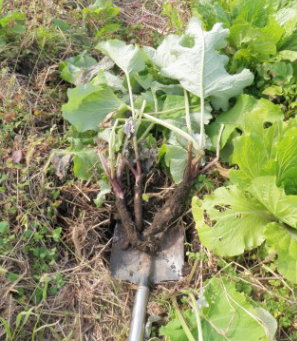Synecoculture Manual
2. Detailed Exposition
2-1. Initial Construction
2-1-1. Ridge Building
First, create a ridge of about 1 – 1.5m width. Do not plow the soil; just pile it into the ridge shape. If you want to raise long root vegetables, deep-plowed soil can make vegetables with good shape but it is not a necessary condition. The ridge width will need to be set at the largest size that allows for harvesting from both sides, so adjust according to the manager’s arm’s reach. If using tools such as a high twig spear for the harvest, allow for a width that makes for easy management.
The purpose of making the ridge is as follows:
- Creating different sunlight conditions for each crop
- Three dimensional usage of the lands to accommodate vegetables with different height
- Increasing arable surface area
- Improving drainage
- Promoting the formation of “briquette structure” in the soil ( see 2-2-3. Grass Management )
- Separating the production area and passage area
- Making the overall management more convenient, etc
If you make a ridge that runs from east to west, you can create two sections:
- South slope for vegetables that favor the sun
- North slope for vegetables that favor shade
Having ridges is not a necessary condition, but it does improve convenience.
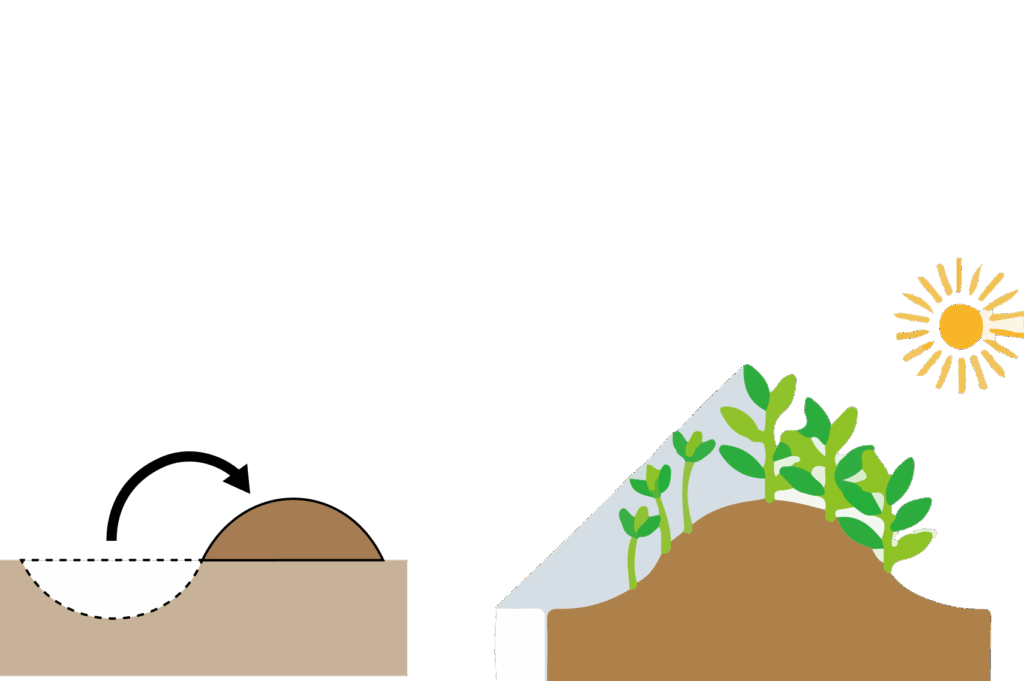
You can be flexible and change the shape of the ridge to match environmental conditions. For example, in a home garden, you may not need to make a ridge and leave it flat. On the other hand, in a dry location, you may want to dig a trench instead to create shades and moisture for the plants. You do want to take into account of the operational cost for grass management and harvest when designing a ridge.
The passage between the ridges should be wide enough for people to pass through when harvesting. Choose a width that allows for ease of work. Use narrow passages if you want to increase the production area. With narrow passageways it’s possible to reach the produce on both sides of the ridge while sitting. If necessary, the passageways can also be cultivated. Root crops are resistant to trampling and can grow in even hardened, tightened soil of the passageway.
2-1-2. Planting Trees
Along the center of the ridge, plant deciduous fruit trees and small shrubs at intervals of 1.5m. The purpose of planting fruit trees is outlined in the 4 points below, in order of priority.
- Creates semi-shade for vegetables
- Summons insects and birds that will promote pollination and provide micronutrients from feces and their dead bodies
- Forms mulch of leaf mold from fallen leaves
- Harvesting of fruit
For the farm that focuses on vegetables, prune the fruit trees to a height within 2-3m.Larger trees should be placed along the edge of the farm so it does not interfere with management tasks on the field. However, fast-growing tall trees are extremely beneficial to the building of the ecosystem. Tree crowns exceeding 4–5 meters also provide a safe heaven for small birds to visit. One method is to plant them in the beginning, and after they’ve set the environment cut them down. The primary purpose of fruit trees is not to harvest but rather to create an environment suitable to the development of vegetable communities. Harvesting of fruit is considered to be a by-product.
For the farm that focuses on fruits, plant a variety of fruit trees in a mixed configuration and have them grow fully. You can grow vegetables as undergrowth of the orchard. To boost productivity, innovative harvesting and utilization methods are essential, such as installing nets to collect fruit that ripens fully on the tree and falls, or processing it into paste and vacuum-packing it for use.
In Synecoculture, it is recommended to introduce the seedlings of wild fruit trees and useful vine plants that are native to the region. It is also important to explore what type of fruit trees can be introduced by actually planting them even if there are no cultivation precedents. Grafted seedlings may result in sprouts from the rootstock, which would require pruning management.

Tip
<Why do vegetables grow well in the shade?>
Contrary to general common sense, non-fertilized vegetables grow better in the semi-shade than in facing the sun. The reason why is that the original breed of vegetables evolved in the mixed dense state with other vegetation, which optimized the capacity to photosynthesize in the conditions where trees provided half-shade.
2-1-3. Perimeter Fence
Vine plants can be cultivated at the fence that surrounds the field. This will serve as windbreaks for the regions with seasonal strong wind. You can also utilize the space along the fence and walls as a nursery. Since such space has relatively high humidity in the field, it provides ideal conditions to grow seedlings in order to constantly supply the plants that are adapted to the given environment, which raises the productivity of the entire farm.
Tip
Vine fruits : kiwi fruit, arguta, yibin, grapes, actinidia, passion fruit, etc.
Vegetables that favor shade : edible wild plants, ashitaba, butterbur, mitsuba, zingiber mioga, leek, shallot, garlic, etc.
Trees that favor shade : zanthoxylum piperitum, lindera umbellata, etc.
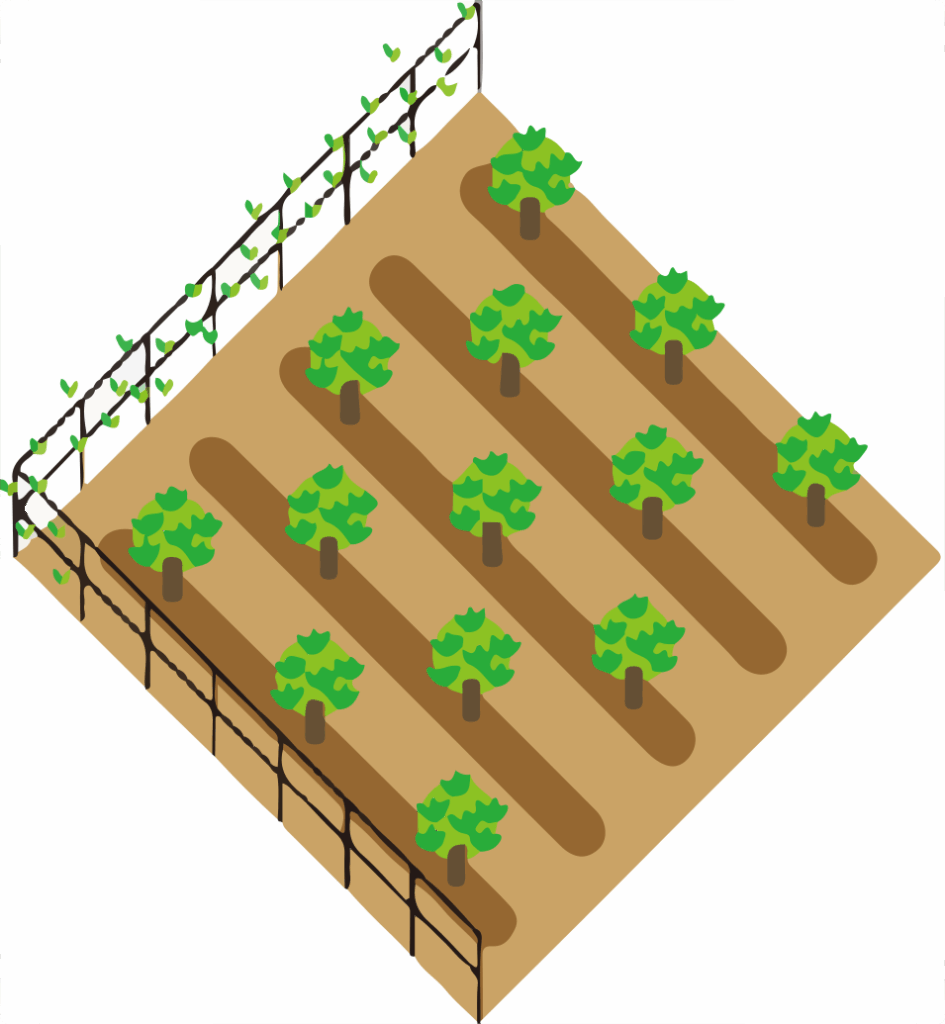
Tip
The fence can be installed using low-cost materials found in a hardware store. Particularly during the winter, production volume can be increased by installing windbreaks. Wind condition also has an effect on the scattering of the seeds.
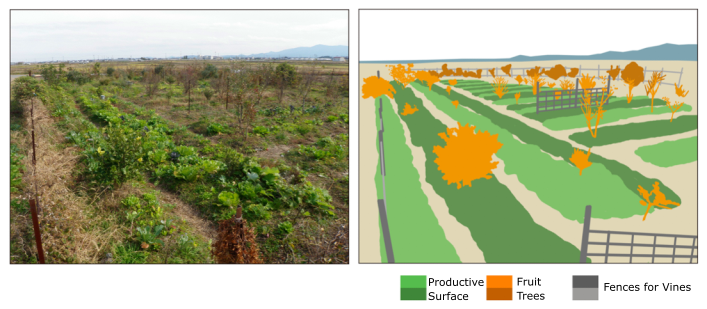
2-2. Management
2-2-1.General Theory of Seeding
For professional farmers, the amount of seeding is determined by calculating backwards from the planned amount of harvest. For home gardens, the ease of grass management should be prioritized and the amount of seeding is determined accordingly.Mix a wide variety of seeds and sow them in a high density. The vegetables should cover the ground, effectively acting as living mulch, before grass forms a community. Regarding affinity among the plants (companion plants): though there is a variety of empirical knowledge in other farming methods, this information is based on the mixing of 2-3 different types at most. There isn’t much information available for non-cultivation, non-fertilizer, and chemical-free methods. Dense mixing of various types of plants is a standard for Synecoculture, and it is necessary to try different combinations without relying on precedents.
You should consider not just spatial distribution when planting, but also the succession of vegetation over time.
Including an appropriate amount of insect repellant plants such as scallion and chives can help stabilize the insect population.
Until the suitable environment for target crops is established, start by planting vegetables that are resilient against insects and harsh environment, such as herbs and Asteraceae (daisy family). This will ensure the yield from the earlier stage of implementation.
Adding perennial vegetables such as chives, Italian parsley, and asparagus from the beginning can reduce grass management for the mid-to-long term, and contribute to the yield.
Depending on the rate of germination and harvest, perform over-seeding, seedling planting, and seedling transplanting within the farm.
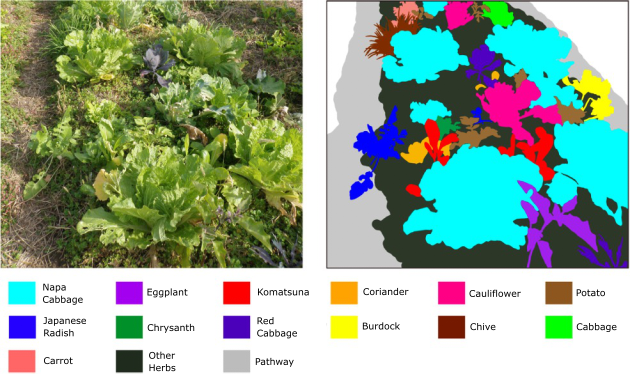
Tip
Seeds of fruit vegetables in summer season and large Brassicaceae vegetables are of a small amount within one bag, and cannot form vegetable mulch on their own.
Using the change in vegetation : for example, after one crop species (beans) have been harvested and withered, it can become the mulch for a different species that will emerge from the ground (potatoes).
Asteraceae vegetables : lettuce, salad lettuce, Korean lettuce, garland chrysanthemum, burdock, chicory, Jerusalem artichoke, etc
2-2-2. Yearly Strategic Planning of Vegetation in Synecoculture
As a basic rule, vegetation strategy should be planned to eliminate any chance of low yield solely due to a “shortage of seeds and seedlings”. To avoid this situation, you should determine the items below at the planning stage in advance.
- Type of vegetables
- Production space
- Necessary amount of seeds and seedlings
As long as the quantity of seeds and seedlings is sufficient, the cause of low yield can be narrowed down to the items below.
- Vegetation planning (arrangement, succession period)
- Management methods
- Climate
With this information you can implement a new strategy. The shortage of seeds and seedling does not give us any feedback information for next year’s strategy, and the whole year will be wasted.
Tip
In Synecoculture, the seed and seedling cost at the initial implementation is higher than that of conventional farming (in case of the introduction of commercial seeds and seedlings). Though since there are no costs for fertilizer, pesticide, and machinery, the overall cost is lower. When planning the budget, It is important to think about not just the cost of seeds and seedlings but the overall cost.
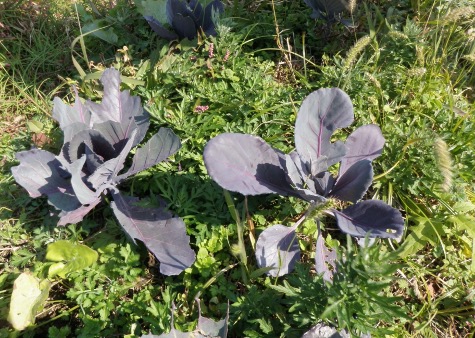
2-2-2-1. Production with a Focus on Annual Vegetables
The example of the spring and summer plans in 2012 for the Ise farm :
Decide which crop you want to have as the primary produce for each month.
- Group A consists of such primary produce that you can expect a predictable harvest. This group needs to be managed and assigned to a specific location.
- Group B consists of the items that have potential to be primary produce, but you can not expect high yield yet since you have not experimented enough in your field. This group needs to be managed and assigned to a specific location as well.
- Group C consists of vegetables that do not need constant management, and can be dispersed widely and randomly as undergrowth.
- Group D consists of any other items that you are experimenting with, including vegetables with special characteristics.
Group A examples (parentheses shows the empirical knowledge at the Ise farm over past few years) :
- Tomatoes (summer vegetable with reliable yield)
- Cucumbers, potatoes, snap peas (reliable yield of beans)
- Okra, shiso (tall, leafy item with reliable yield),
- Chives (perennial with a stable yield),
- Scallion (It is fall/winter vegetables but can be harvested in spring/summer as well),
- Green onions, burdock, parsley, Italian parsley (reliable yield in the winter)
- Shima shallot (year-round harvesting is possible)
- Mountain udo (thinning of a shoot increases yield from spring to the beginning of summer)
- Moloheiya (can be harvested until fall without losing to the summer grass)
- Water spinach
Group B examples :
- Eggplant (summer vegetable with an uncertain yield)
- Bitter gourd, taro, sweet potato, bell pepper, green pepper, red pepper, zucchini, pumpkin, melon, watermelon
- Soybean (shipped as edamame bean)
- Azuki beans, cowpeas, groundnuts (covers the ground but loses to strong grass)
Group C examples :
Carrots, turnips, radishes, lettuce and similar leafy vegetables, Japanese mustard spinach, mizuna, mibuna, bok choy
Group D examples :
- Coriander (strong smells; with its peculiarity it won’t sell out even if large quantities are made)
- Saffron, asparagus, arugula, herbs
Once you have decided the primary produce from Groups A and C, determine the planting area of A and the sowing amount of C according to the planned yield (how many boxes of vegetable delivery you want to ship per month).
After planting of Groups A and C is done, you can experiment with Group B in an extra space. This experiment could be successful and produce additional yield but even if it fails you will still have enough of your primary produce.
Since March and September are transitional periods from winter vegetables to summer vegetables and vice versa, there is a risk that you run into vegetables shortage. To ensure the yield during this period, following 3 measures can be applied.
- Aside from the production area mentioned above, create an extra space where two months worth of vegetables can be grown without much management and plant seedlings there. In Ise farm, an empty space nearby was mowed and utilized for this purpose. As long as you can save them for harvest in March and September, it does not have to produce high yield. You’ll have more flexibility to respond to fluctuating yield if you manage three-tenth hectares at the same time, including this backup location, than focusing on managing one-tenth hectare.
- Harvest vegetables when they are in season, and then make preserved food through traditional methods, like pickling, to complement the low yield in March and September. Brassicaceae-hybrids and shallots are great for pickling.
- Besides conventional food products, you can make use of wild plants, seedlings and fresh flowers, such as butterbur sprout, butterbur seedlings, plum flowers, etc.
For Group A, diversifying the vegetation density can disperse the risk. For example, densely planted okra is resilient against strong winds such as typhoon, however it withers in November and there aren’t many things that can take its place, making it difficult to transition to the next vegetation. By reducing the okra density, seedlings such as lettuce can be planted in between, for the purpose of succession after okra withers. Since there are advantages and disadvantages depending on the density, make sections with varying combination of densities. This is a specific example of the environmental conditions diversification in 1-9. Search Method Search Method.
Tip
Synecoculture, which utilizes flowers and seeds, easily crosses Brassicaceae vegetables, creates hybrid species. Brassicaceae-hybrid vegetables do not have a name and are difficult to sell on the general market, but with their good flavor and tendency to have a high yield, they’re valuable as a processed food ingredient. They are also suited as materials used in restaurant cuisine.
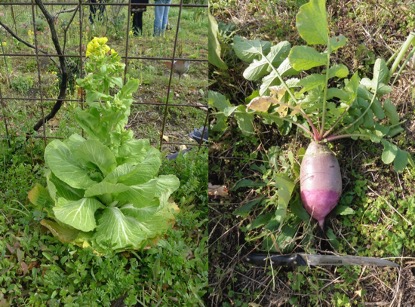
2-2-2-2. Low Cost Production with Focus on Fruit and Perennials with Some Vegetables
In a subtropics temperate zone where the grass is strong, and if you want to take advantage of abandoned fields, reducing management costs becomes priority over the productivity per area.
The strategy to achieve this is to have fruit trees, which can survive if left alone as opposed to the annual plants that requires frequent harvesting and shipping, be the primary crops for the farm and mix them with the vegetables by taking advantage of the soil environment made by naturally occurring, perennial plants. The soil structure provided by annual plants are considered by-product and are utilized secondarily as they form.
Tip
Synecocluture farm can be designed in numerous ways to meet each farmer’s objective. In contrast to conventional farming methods that use predetermined procedures and requires constant management effort, Synecoculture methods are highly customizable that can sustain both high productivity farms with daily harvest and medium productivity farms with occasional harvest and mowing (lower maintenance cost). Depending on the objectives and budget, decide the cost and level of productivity you want to achieve, and design the vegetation accordingly. This flexibility allows Synecoculture to be implemented even in an area that is considered unsuitable to practice conventional farming.
Example below shows the spring and summer plans for 2014-2015 for the Ise and Oiso farms :
- Group E : Consists of fruit tress that are strong against grass invasion and adapts well to wasteland.
- Group F : Consists of vegetables that can germinate on their own from seed form even among colonies of weed.
- Group G : Consists of vegetables that grows better when planted in seedling form instead of seed.
- Group H : Consists of vegetables that needs a little assistant as their seed does not germinate unless the grass is mowed and topsoil is partially removed to eliminate the inhibitory effect of past vegetation.
First, decide on the location for fruit trees in Group E and plant them in large quantity. Second, plant vegetables mainly from Group F among the trees. These two Groups will be the primary crops, and Group G and H can be introduced if you want to increase production volume or if you want to have better control of weed expansion.
Group E examples :
- Persimmon: cultivar and native date-plums
- Loquat: cultivar and native meliosma rigida
- Cirtus fruits: sweet Chinese citron, oranges, kabosu, lemon, etc.
- Plum, cherry tree types: plum, Nanko Ume (southern plum), nanking cherry, Japanese plum, cherry blossom, apple (two types or more make for better fruit bearing rate), angsana, etc.
- Figs: western and Japanese figs, wild figs
- Elaeagnus: silverberry, native autumn olive, etc.
- Berry tree: blueberry, Amelanchier canadensis, wild Vaccinium bracteatum, etc.
- Tree nuts: chestnuts, wild Japanese chestnuts, walnuts, hazelnuts, etc.
- Other: feijoa, eucalyptus, etc.
Group F examples :
- Apiaceae : carrot, parsley, Italian parsley
- Asteraceae : lettuce (strong species of bitterness), chicory (strong allelopathic grass, does not lose to perennial plants), Jerusalem artichoke (occupies the community), burdock (grows even in hard ground)
- Legumes: soybeans, kidney beans, peanuts, velvet beans (also strong against tall grass)
- Potatoes: potatoes, taro (prefers wetlands), Jerusalem artichoke
- Root crops: garlic (does not lose to grass even if buried), shallot, chives, burdock, carrot
- Other mulch-types that crawl along the ground: strawberry types, herb types (mint in particular)
- Predominately shade types: mitsuba, leek, Zanthoxylum piperitum, nandina
Group G examples :
- Plant species with high establishment rates of seedlings even within grass: perilla, pepper, lettuce (cultivar), leek, tomatoes, cucumbers, cabbage, broccoli, artichokes
- Things that becomes shrubs upon growth: tea plant, raspberry, kidney beans, velvet beans
- Predominately shade types: butterbur, leek, ferns
Group H examples :
- Lettuce (cultivar), Japanese mustard spinach, etc.
Vegetables in Group F are the easiest to manage as these vegetables are capable of germinating on their own and propagate themselves. As there is no need to disturb the topsoil, this is the most useful for ecosystem construction. By keeping vegetables in Group F dominant, the management costs will be lowered while maintaining a certain degree of harvests. Even left untouched for long time, these vegetables will resurge after mowing the grass.
For Group G, there are advantage and disadvantage. The advantage is that you can manage and control them easily since they are planted in seedling form. The disadvantage is that if large quantities are planted continuously, the topsoil will deteriorate accordingly, and there are cases that the residual chemical fertilizer on the commercial seedling soil will accumulate over time. Whereas, items such as Japanese basil and artichoke are capable of reproducing themselves at the same location once they are planted, making them high value items.
Many of F and G are biennial or have characteristic similar to biennials.
Many items in Group H are annual vegetables that are selectively bred to be commercially viable.They are modified to suit the conditions of conventional farming and the production outputs do increase thanks to the crop improvement; however, so do the management costs and destruction rate of the topsoil.
The initial vegetation of the Oiso farm and the overall productivity achieved at the Issé farm are analyzed in [Funabashi 2024] .
Tip
For potatoes and root vegetables, rather than leaving them be, moderately harvesting and disrupting them can increase the yield. They will be dug up during harvesting, so the perennial plant roots can be cut and controlled. For potatoes, if you thin out the above-ground portion of sprouts to leave a single stem from a root, the swelling of the potato can be observed.
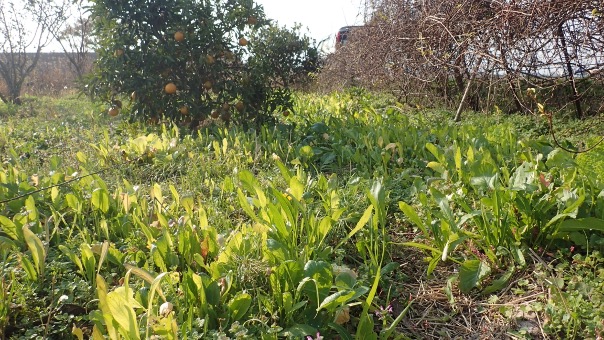
2-2-2-3. Home Garden
Synecoculture can be practiced for small-area such as home gardens with the object of self-sufficiency. There is a precedent of a small space of 4m2 with right choice of species and variety that produced year-round vegetables for a number of servings. We will show the grouping patterns as a hint for home gardening implementation.
Group I :
Vegetables that you can expect to harvest from an early stage by thinning. They are grown by sowing the multiple types of seeds and letting them mix in high density.
- Focus is yearly leafy vegetables such as lettuce, Japanese mustard spinach, radish, rucola, etc.
Group J :
Vegetables that can build a suitable environment where continuous production is possible. These crops needs to be planted in bulk to some extent.
- Brassicaceae vegetables : Such as cabbage, broccoli, Chinese cabbage, cauliflower, etc
- Fabaceae vegetables : Such as kidney beans, soybeans (green soybeans), peanuts, etc
- Apiaceae vegetables (perennial) : Such as parsley, Italian parsley, etc
Group K :
Root vegetables. They can be planted in the gaps among other vegetables, or in places where other produce does not grow easily. They increase efficiency and yield from your garden.
- Carrots, radish, burdock, shima shallot, green onion, potatoes, taro, etc.
Group L :
Vegetables that need careful management to prevent it from overly dominating other plants.
It is useful to have in a small amount. Herbs, garlic, Japanese ginger, mountain udo, ashitaba, asparagus, butterbur, strawberry, Zanthoxylum piperitum, flowering plants, etc.
Tip
The characteristics of root vegetables can be utilized in combined strategies with other vegetable groups, such as arranging them in a line to block the invasion of other grasses, planting other seedlings in anticipation of the soil that will be dug up during the harvest, and sowing the seeds of lettuce and Japanese mustard spinach, which are easy to germinate after the disturbance.
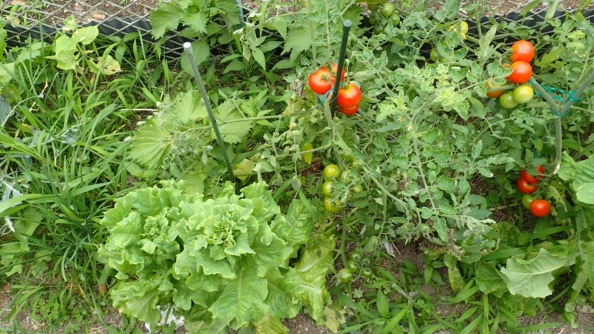
2-2-3. Grass Management
Knowing the characteristics of each vegetable and grass allows you to perform efficient grass management in response to their characteristics (“control grass by using grass”).As long as the vegetables aren’t losing out, do not remove the annual grass. Remove only the perennial grass that forms a community, and the annual grass that becomes too big. If using a lawnmower, cut the grass that grows taller than the height of the vegetables to reduce growth rate of the grass and create an environment that favors the vegetables. If germination has already occurred and it would be difficult to mow through the scattered vegetables, then remove the grass manually during harvest or while planting seedlings.It’s best to pull out perennial grass from the roots; however, if they are large then cutting the part above ground repeatedly can shrink the underground root, which contributes to the formation of soil structure. Perennial grass may be allowed to grow on the non-ridge passage areas. Annual grass withers in the winter, forming briquette structure with pore space in the soil. Perennial grass tightens and hardens the soil without withering, but it can also enrich the soil environment and terrestrial ecosystem.
<Briquette Structure>
It describes the physical aspect of the soil structure. After the roots of annual grass spread underground and wither within the soil, they leave interconnected pore space similar to a briquette structure. This tightly knit structure strengthen the resilience of the soil and provides excellent ventilation and water permeability, making it strong against physical disturbance from wind and rain.
2-2-3-1. Three Basic Methods of Grass Management
- Mowing everything: In order to restart/reset the field where the grass dominates the vegetables, it is best to cut the grass and vegetables all at once to the ground level. The height of what remains can be anywhere between the ground level, slightly above the ground to 10 centimeters depending on your seed-planting strategy after the mowing.
- Mowing to the height of vegetables: If the vegetables and the grass are competing and the grass is growing taller, cut the grass down to the vegetable height. Only the grass will be damaged and it will become easier for the vegetables to dominate.
- Removing Large Grass: Individually remove the grass that stands out such as the perennials community or the annual grass roots that grow too big.
Methods 1 and 2 can be applied to surface. Thus, it is easy to take care of large area at one time. In some cases, it is not efficient to conduct these methods especially when the height of the vegetables varies greatly or when the newly sown seedlings are still around.
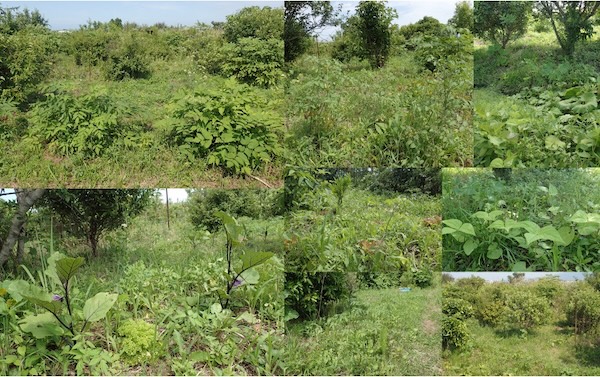
2-2-3-2. Soil Formation through Controlled Propagation of Grass
There is also a method of allowing weeds to grow thickly in summer so that the soil will be ready again for harvest from fall onward.Although it reduces the yield during summer, this strategy is effective because the weeds prepare the soil for higher productivity in the following seasons and labor costs can be reduced during the heat of summer. During this time, you can either leave the field alone completely or harvest the remaining vegetables and cultivate tall plants, like tomatoes in a bush. When the summer ends, use a lawn mower to cut down all the vegetable and the grass and sow seeds right on top.The mowed grass becomes mulch and serves as camouflage for the seeds against animals and insects. The growth rate of weed slows from fall, making it easier for vegetables to dominate. You can use this method of “mow everything and restart” until the vegetables become the dominant force, not just in summer but anytime when weeds are overpowering.

2-2-4. Production Deadline
The essence of Synecoculture lies in the informational management of the dynamic ecosystem in order to maximize its productivity while reducing the cost. Therefore, it is very important to manage production schedules and set appropriate deadlines for each season. If the deadline is not met, you need to either scale down the current strategy or change it entirely. Otherwise you will end up reacting after the vegetation has changed. The deadline for each task varies depending on the climate conditions of the year. The following dates are based on the experiment in Honshu, Japan, mainly in the Kanto and Kinki regions (at north latitude 34-36 degrees). However, in recent years, erratic weather patterns have become increasingly frequent, making it crucial to implement multiple, multi-stage strategies based on the potential for changes in temperature and precipitation.
- Deadline for spring seeding. From April, switch from seed to seedlings because the weed growth gains momentum around this time,
- Beginning of May (“Golden Week” holiday period in Japan): Many seedlings for summer fruits and vegetables start to appear in hardware stores. However the seedlings for summer vegetables grows better when planted later in the month with no-fertilizer condition, so this is simply a distribution deadline.
- 1st Week of August: Mow the summer grass, sow the seeds of the root crops, and start preparing seedlings for fall and winter vegetable.
- 1st Week of September: Mow the grass at the transition to fall, sow the seeds of fall and winter leafy vegetables, start preparing seedlings of winter vegetables.
- September 10th: Time limit for sowing fall leafy vegetables.
- September 15th: Decision deadline for the growth quality of fall vegetable seedlings. If the growth is bad, prepare to obtain new seedlings from a specialty shop or hardware store.
- September 30th: The last day for planting seedlings of fall vegetables.
- October: Observe the progress of fall vegetables, and begin sowing for the winter vegetables.
- Middle of October: Time to finish planting the winter vegetable seedlings. These plants are expected to grow until November.
- Next January: Construction work for the field, set up an anti-wind fences, cut the bamboo forest, prune and transplant the fruit trees, and plant the perennial grass seedlings. These activities should be performed in the middle of January so that seed sowing and harvest management from February onwards can be handled smoothly.
Tip
When deadline is not met, it results in cost increase and reduction in yield due to excess weed invasion into vegetation area. Conversely, deadline should be set to hedge these risks.
Leek, arugula, shima shallot, mini-tomato, etc. can be undomesticated easily and adapt to a wild environment of Synecoculture in a similar manner to weeds. Seeds from raw fruit such as watermelon and pumpkin are stronger than commercially distributed seedlings. Cucumbers grow well when sown near a tree at the end of May to the beginning of June. They thrive by tangling themselves up around the tree, in a way similar to their parent species in natural environment. Tomatoes in conventional farming often propagate self-sown seedling that can be pulled out and transplanted to Synecoculture field, which creates long-lasting bushes of creepers from summer to winter.
2-2-5. Grass Management, Seeding, and Planting of Seedlings in Summer Season
When deadline is not met, it results in cost increase and reduction in yield due to excess weed invasion into vegetation area. Conversely, deadline should be set to hedge these risks.In Synecoculture, where the ecosystem is proactively controlled through information rather than material resources, the timing to take the initiative is the most important. If the opportunity is missed, not only will it be a waste of effort, but it will also have an effect on the yearly scope of the yield until the next spring.
If a certain strategy didn’t work, you should switch to the next strategy, and plan at least 4 to 5 steps in advance, so that the work itself is light and can be completed in the shortest amount of time possible.
2-2-5-1. Principle of Three Way Trade-Off -Example of Summer Strategy in Honshu, Japan
During August and September, mowing grass, sowing seeds and planting seedlings are conducted, but it will be necessary to consider the balance and trade-off of following three aspects:
- Soil formation of briquette structure through summer grass
- Decomposition of mowed grass
- Benefits of early sowing of fall/winter vegetables
These three points outlined below are concurrent and are in conflict with each other; therefore, it is important to make appropriate judgments of priority and timing, and address each point in balance.
- Have the grass grow as thickly as possibleIn order for the grass roots to form the soil structure, the annual grass must be grown as thickly as possible. For this reason, the later the mowing of the grass, the better for soil formation.
- Have the seeds germinate as quickly as possibleIn Synecoculture, plants are not watered after transplanting unless necessary or during severe drought, and no external fertilizers are applied. Consequently, growth is slow, requiring plants to reach harvestable size in dense, mixed stands by mid-November when frost halts growth.In order to make this time line as long as possible, it is necessary to sow as early as possible: two to three weeks earlier than usual. This is directly in conflict with (1) because you cannot wait too long to mow the summer grass.
- Have the mowed grass decomposed as much as possibleMowed grass is decomposed fairly quickly with the help of rain in August, creating natural humus by the beginning of September. This decomposition should take place at the location where vegetables grow to increase productivity. However, if 1 and 2 are given priority, the mowed grass needs to be pushed aside to a passageway before the decomposition takes place, in order for the seeds that are sowed in the middle of August to germinate. If you are sowing in the beginning of September, it is possible that decomposition takes place in time and you can leave the mowed grass on the ridge.
To balance these decisions could be difficult; in this case, you can simplify the decision process by pushing the mowed grass to a passageway from the beginning. This way, 3 are removed from consideration. In the beginning of August, have the mowed grass become humus at the top of the ridge, and proceed with the growth of the slow-growing root vegetables. Then in the beginning of September you can take priority to proceed with the leaf vegetables, by putting the mowed grass in the passageway that can be used later as dead grass mulch for seedling.
Chopping cut grass into small pieces facilitates decomposition and allows seeds to germinate through the gaps. In dry areas especially, grass that isn’t finely chopped may be difficult to decompose.
The mowed grass should be decomposed as much as possible, while when sowing the seeds, it will be necessary to move any non-decomposed grass. The mowed-grass mulch can be kept until it will be gradually decomposed in September and plant the seedlings. Even if it doesn’t decompose you can simply push them aside just enough to make a space for the seedlings.
Tip
In order to have vegetables be dominant as the grass changes from summer to fall, the period from the end of August to the first week of September is the most crucial.Even if it doesn’t decompose you can simply push them aside just enough to make a space for the seedlings.
2-2-5-2. Example of the Relationship between Mowed Grass and Seeds and Seedlings
Plan a production schedule at the same time as you mow summer grass, so that a variety of vegetables are growing densely enough for continuous thinning harvest, through fall to the following spring season.
Here are the examples:
- The end of July to August: Sow root vegetables such as carrots.
- Mid-August: Sow seeds of mustard family ( Brassicaceae ) such as cabbage, Chinese cabbage, and broccoli.
- First week of September: Sow all types of leafy vegetables. Daikon radish should be sown by September 15th.
- In general, you want to finish seeding as soon as possible; therefore, August is the optimum time for seeding fall/winter vegetables up until September 10th. For large vegetables that will contribute to the next round of yearly yield, finish sowing by the beginning of September.
- The end of August to the beginning of September: Sow leafy vegetables especially the ones that grow fast but are susceptible to mowing. Sowing these seeds at the end of summer grass mowing is critical for their success. Such vegetables include Japanese mustard spinach, radish, and any undergrowth vegetables that become living mulch.
- The beginning of August to the beginning of September: Sow root vegetables every time you mow grass. Sowing these vegetables frequently at intervals allows for continuous thinning harvest.
- Items such as green onion and chives can be harvested only from second year. Seedling of cabbage and broccoli may grow slow in the first year, but you can expect to harvest them in the following year. The objective is not to grow everything bigger but to differentiate the growth rate among the crops.
Tip
<Difference in strategy between root vegetable and leaf vegetable>
In general, you want to sow them in August, but there’s a chance that the summer grass will come out again and bury crops. Therefore, use the slow-growing root vegetables (carrots, radish, Japanese shima shallot, etc.) after mowing the grass in August.This way there’s no need to push aside the mowed grass as they are decomposed quickly, besides even if these root vegetables are mowed or buried, they will regain strength fairly quickly.
Depending on the characteristics of the seed, you can either choose manual broadcasting or sowing in a furrow and cover with the soil.
Broadcasting is the simplest method with low workload, but it can be also harder for the seeds to germinate. If time permits, scratch the surface of the soil for better results. Leaving 10cm of surrounding grass prevents birds from eating the seeds and sprouts.
You can expect a better rate of germination by sowing in a furrow, but this requires more labor.
Combine the cons and pros of broadcasting and sowing in a furrow, and plan a strategy to make best use of the space. In a narrow space, a furrow provides better germination rate. In a broader space, introducing seedlings can offset the downside of broadcasting such as the lower germination rate.
When broadcasting the seeds, leave the grass 10cm from of the ground when mowing, which will act as a deterrent, making it difficult for birds to eat the seeds.
If the mowed-grass mulch covers seeds too much, they will not germinate or turn into frail sprouts, so it is necessary to remove any excess into the passageway. They become passageway mulch or can also be used as the mulch when planting seedlings. Having mowed-grass mulch around the seedlings protects small seedlings and prevents grass from growing.
If the sown seeds are losing to weeds, trim them at the vegetable height. For example, mow all the grass to a height of 20cm from the bottom.
When sowing seeds in October, strip away the withered grass mulch then sow. In contrast, if you want to let the soil rest until next spring or if you do not want to manage the entire area, cover partial area with the withered grass mulch.
The mixture of vegetables in high density, the underlying principle of Synecoculture, is performed starting from seed sowing. Seedlings are used as a supplement until the seed germinates, since it is harder to achieve high density only with the seedlings. Seedlings are particularly useful for large vegetables such as mustard family (Brassicaceae), because it is difficult to determine when to sow their seed in August:Summer grass imposes fierce competition against the seed sown in August. Therefore, large vegetables can be better managed by planting the seedlings toward the end of summer to avoid weed competition and reduce the labor in the heat. Seedlings for larger vegetables are also useful in a drought when moisture is not sufficient for the seed to sprout. You can either prepare seedlings on your own while sowing or order them from the seedling shop in advance to meet the deadline.
In certain cases where too many vegetables are competing for a given space, you can transplant parts of them to less crowded areas in September. In regards to grass mowing and seeding, it is essential to assess the circumstance accurately. This process cannot be standardized since each case, depending on what you want to focus, calls for different priorities. Some degree of empirical knowledge is required to make these decisions.
Tip
If you do not want to run out of harvest in August, for example for the restaurant business, you should plant seedlings as early as possible to bridge the gaps. Designating August as a break period allows the summer grass to grow, but at minimum you need to devise a strategy for fall and winter during this time.

2-2-5-3. Fall Vegetation Plan
To plant the seedling in fall season, you can simply push aside the mulch on the surface area, but more importantly, you need to create a vegetation plan for the following spring season.Here’s an example of the transitional strategy: fava beans and kidney beans are planted in November to mix with other leafy vegetables (radish, bok choy, mibuna, etc) since they do not grow tall during winter and do not compete with leafy vegetables. As you harvest the leafy vegetables in winter, they start to withdraw their presence and in turn beans starts to dominate when spring arrives.After the spring, beans wither and become mulch, giving ways to potatoes and other leafy vegetables for the following season.
2-2-5-4. Irrigation
As a basic principle, you do not need to water the seeds. Simply let them germinate on their own. Use of cheesecloth is permitted only during the germination period.An exception to this principle is when dry weather persists following the sprouting of the seeds or planting seedlings. In this instance, you do need to water otherwise you will run the risk of ruining all of the crops. Having a sprinkler system as a temporary measure after the sowing of August and September can greatly reduce this risk. However, be mindful of excessive watering. When vegetables are excessively saturated with water, they will deviate physiologically from ecological optimum state and lose their original taste, a key characteristic of Synecoculture produce.It is true that all plants need water to grow. If it does not rain much in the fall, the vegetables will remain small throughout the winter and they will stay small through following spring. For this reason, an appropriate amount of watering is acceptable. If using a sprinkler, use it on an as-needed basis during August and September and discontinue use thereafter.
During the rainy season, typhoon season, and autumn rains, checking precipitation forecasts in advance or observing the sky can help predict rainfall patterns. By scheduling work immediately before expected rainfall, you can efficiently promote seedling transplantation and germination growth. Ideally, performing both grass cutting and seedling transplantation within the window starting about half a day before significant rainfall begins and lasting for several hours afterward allows efficient work. This enables building plant communities and soil structure by riding the natural rhythms of the weather.
Tip
Even without irrigation, seeds are able to sense their own environment and determine the time that is suited for germination. On the contrary, when using artificial irrigation to force germination, the growth process becomes frail and it will be necessary to assist their lives afterwards. Throughout a long history of evolution, plants have been able to overcome multiple climate changes through spontaneous judgment and growth, so it is important to encourage environment adaptability of vegetables.

2-2-6. Alternatives to Fertilization (Method of Recovering Productivity)
The concept of human-provided fertilizer does not exist in Synecoculture. All vegetations provide themselves the essential nutrients through photosynthesis, which is a direct interaction, and through indirect interaction with animal fauna.In an ecosystem in nature, plants produce organic matter by photosynthesis, and the animals disperse phosphorus, potassium, and other micronutrients. Any human-introduced materials into the ecosystem are considered foreign materials, and can be compared to an accidental introduction in nature such as landslides.
Phosphorus, potassium, and other micronutrients may become insufficient due to continued harvesting, however vegetation such as shrubbery and fruit trees will be introduced to encourage these supplies through diffusion from birds, insects, and other animal groups.As long as no chemicals or external fodder are used, livestock may also be introduced.
When it becomes necessary to restore soil productivity through external means for some reason, considering the principles of ecological cycles, the following three methods can be cited as examples during the initial soil improvement phase. However, they violate the principle of Synecoculture that “humans may only introduce seeds and seedlings.”
- Sprinkle seawater about once a year. Dilute with 1:100 ratio of seawater and water
- Grind seaweed or fish leftovers and spread them over the surface (this is a direct way to restore soil nutrients that has run off into the ocean via underground water, caused by the conventional farming)
- Put grass and fallen leaves (humus) on the soil surface. Take them from a neighboring location that is not affected by pesticide.
Tip
Wild plants gather all nutrients needed for their growth by themselves. This results in unique geographic distribution of plants and environmental conditions, which is referred to as an ecological niche. The natural ecosystem does not turn into desert as long as there is sufficient rainfall and equitable species diversity: It self-organizes and maintains the diversity of ecological niche, as well as supports the sane metabolism of individual plant within.On the other hand, human-cultivated vegetables that are made with fertilizer and watering have significantly altered metabolite, which can be compared to the metabolic syndrome of humans.
The 3 alternate methods to fertilizer have its root in the material circulation between the ocean and the land, which was established in the course of evolution.These alternatives make use of this existing natural circulation and making it more efficient by shortening the route. Therefore, it makes the most economical sense to encourage birds, insects, and microbes to do the work for us rather paying the cost of these alternatives.
These methods are acceptable for initial soil management especially when converting a housing site to an agricultural land, where the ground is leveled and the vegetation and organic matter in the topsoil are scarce. However, to be certified as Synecoculture, it is necessary that the growth of the plants is completely free from external organic matters. To establish plants’ self-perpetuation to the standard of Synecoculture, it is essential to maintain productivity without depending on the external supply.
Commercially available varieties of vegetables like eggplant and corn, which have been bred specifically for use with fertilizers (especially summer-bearing fruit vegetables), may experience drastically reduced yields when grown without fertilization.In these cases, it is possible for the practitioner to utilize non-plow organic farming method and put on a fertilizer on the soil, however, the vegetables produced in this way is not considered as Synecoculture produce.
2-2-7. Harvest
In the high density of mixed vegetation, harvesting is done by thinning-out from the crops that grew large out of competition. Once the environmental conditions are established, daily harvesting is possible year-round.When cutting off the crops, it is better to leave the roots in the ground because they will protect the soil and encourage the vegetation to regenerate. Only certain cases, for example, if you are shipping the produce to a long distance, you can harvest the whole plant with the root intact so the vegetables stay fresh for longer period.
2-2-8. Sequence of Harvesting – Seedling Transplant – Overseeding
As you harvest or mow the large grass, these newly created spaces and exposed soil should be filled up either by transplanting new seedlings or by over-seeding in order to maintain high density of edible plants and prevent grass from gaining ground.You can also utilize unused spaces in the field as nursery, such as by the fence/wall or in a shade with plenty of moisture, since this makes it easy to transfer seedlings within the farm. Once there is an open space in the nursery, sow more seeds. In this manner, harvesting, transplanting of seedlings, and sowing of seeds can be carried out in a sequence and at the same time.
In the diagram below, we show the schematic example of this sequence. After harvesting produce A, transplant the seedlings of a produce B from the nursery to where A was, and over-seed with produce C in a nursery where seedling B was. Harvesting, transplanting, and over-seeding are done in one set of action.
In the same manner, the harvesting of produce B – transplanting of produce C – over-seeding of produce A, as well as harvesting of produce C – transplanting of produce A – over-seeding of produce B are shown in parallel.
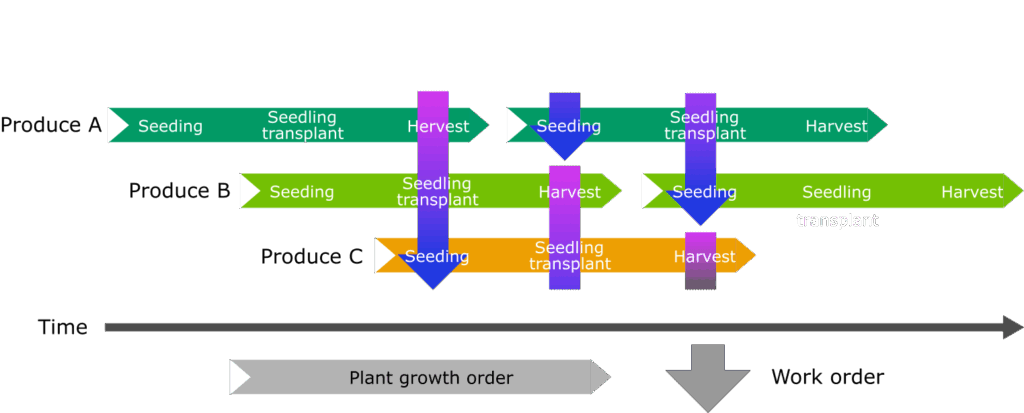
Tip
In conventional farming, their basic principle is in the physiological optimization, and seeding, growing seedlings, and harvesting is done in a same location that is isolated from other crops (mono cropping). In Synecoculture farm, we optimize space and time of multiple crops simultaneously. The work sets (seeding, transplanting, harvesting) are performed with a time lag between the crops, and we spatially move around the plants to a place that is most suitable in a given situation.
In reality, you do not need to strictly adhere to this sequence (harvesting – transplanting – over-seeding) but rather be flexible to make a decision based on the situation. Sometimes, it is better to over-seed instead of transplanting and vice versa.
For example, after the initial sowing, you need to assess the rate of germination, and if the rate is low, you will proceed with over-seeding.
2-2-9. Self-Seeding
Some proportion of the vegetables should not be harvested so they can fulfill their life, and leave until they bloom flowers and form seeds.Practically speaking, it is nearly impossible to harvest all the vegetables in a highly dense and mixed culture, therefore there will always be seeds left to some extent for later use. In order to increase the quality of open-pollinated seeds in Synecoculture, you need to select the seeds that showed superior genetic and adaptive traits: For example, take the seeds from the crop that grew larger in a given environment rather than the ones that did not adopt well to the same conditions. This way you can ensure and ameliorate the yield of the strain for the long period of time.
We have observed that the seedlings grown in a synecological farm are far more vigorous and resilient in a harsh environment than commercially distributed seedlings that are grown with chemical fertilizer. It suggests that those seedlings from Synecoculture changed their metabolism and expanded their habitable environment where they can survive. In some cases, we also observed the extension of harvesting period as a part of adaptation.
Tip
We predict that the seeds obtained from synecological farm will be effective and useful when developing a new farm in a harsh and volatile environment.
2-2-10. Ridges
Unless it is physically destroyed by natural disaster, there is no need to add soil to the ridge because they will gain resilience against erosion with the help from the plants. Annuals contribute to this by creating briquette structure (compacted soil structure with abundant air holes) in the ground. The root of the perennials and trees also assist by holding the soil intact.In fact, this mechanism is exactly the same as how the mountain holds its shape over the years. In case the ridges in your farm keep collapsing, you may need to reevaluate the way the grass is managed.
Tip
We have observed that the seedlings grown in a synecological farm are far more vigorous and resilient in a harsh environment than commercially distributed seedlings that are grown with chemical fertilizer. It suggests that those seedlings from Synecoculture changed their metabolism and expanded their habitable environment where they can survive. In some cases, we also observed the extension of harvesting period as a part of adaptation.Unless it is physically destroyed by natural disaster, there is no need to add soil to the ridge because they will gain resilience against erosion with the help from the plants. Annuals contribute to this by creating briquette structure (compacted soil structure with abundant air holes) in the ground. The root of the perennials and trees also assist by holding the soil intact.

2-2-11. Seedling Strategies
Although you can purchase seedlings from a local shop or a hardware store, you can grow them at home when they are not available in an off-season. Homegrown seedlings are especially useful because it is possible to realize a longer span of harvest beyond the commercial distribution period.
For example, tomato seedlings are available at the store from April to May, but upon planting, most of the harvesting of these tomatoes will take place from July to August. On the other hand, if you grow your own tomato seedlings in a nursery it is possible to plant them until August. By planting the seedlings incrementally up to August, you can prolong the tomato harvest until around November. If we also utilize the unripe tomatoes, the harvest period can be extended until December in some cases.
In order to improve the efficiency of Synecoculture production volume, it is useful to set a small green house or a room, where you can control physiological conditions to grow seedlings, as a backup supply system. This way, anytime you need to fill the space in the production area after harvesting, you always have a backup of seedlings. To increase the yield while eliminating the gap of crop transition, the farm and nursery should always be packed with produce and seedlings.Fluctuations in the natural environment can result in poor produce development, however it is possible to stabilize and keep efficiency of production by arranging the supply system of seedlings that can absorb the volatility.
Tip
Even for the cultivation and transplanting of seedlings, you must keep the non-fertilizer principle and should not introduce any external organic matter in synecoculture field. It is best to grow seedlings without fertilizer.As for hydroponic cultivation with indoor environment, it can be used in the nursery stage since the transplant does not require soil, and therefore it does not bring external organic matter into the field. However, without sufficient time of growth on site it will not become a healthy part of the vegetation in terms of plant metabolites.Hydroponic cultivation is suited for automated production of the seedlings of certain perennial vegetables, such as Italian parsley, that can take sufficiently long time to achieve ecologically optimal growth on site until harvest. For annual grass vegetables, the period from plantation to harvest is short, so there is the risk of their metabolites being influenced too much by liquid fertilizer.
